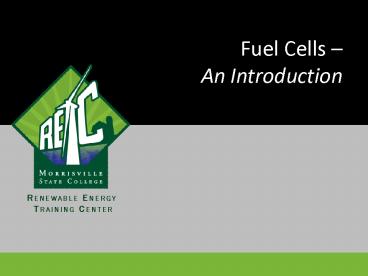Fuel Cells An Introduction PowerPoint PPT Presentation
1 / 24
Title: Fuel Cells An Introduction
1
Fuel Cells An Introduction
2
Overview
- Batteries vs. Fuel Cells
- storage vs. conversion devices
- General overview of fuel cell types
- Introduction to Dr. Schmidts fuel cell/gas
battery experiment (lab activity) - Relationship of the gas battery fuel cell
effect to PEM fuel cells - Challenges of fuel cells
3
Batteries
- A battery (or electrochemical cell)
- Two electrodes made of dissimilar metals, are
immersed in a conducting liquid electrolyte. - When you construct an electrochemical cell, you
create a voltage between two electrodes. - Current flows from the positive to negative
electrode until chemical changes stop it.
4
Chemical Energy Storage
- A battery is a store of chemical energy that can
be converted into electrical energy. - As electrode chemical reactions proceed, chemical
energy is converted into electrical potential
energy. - Chemical energy is exhausted when reaction can
proceed no further - (e.g. when a Zn electrode is dissolved in a
sulfuric acid Cu and Zn cell.)
5
Fuel Cells (vs. Batteries)
- Fuel cells are devices that convert fuel (such as
hydrogen, methane, propane, etc.) directly into
DC electricity. - The process is an electro-chemical reaction
similar to a battery. - Unlike a battery, fuel cells do not store the
energy with chemicals internally. - Instead, they use a continuous supply of fuel
(chemical) from an external storage tank.
6
Fuel Cells
O2 4e- 4H ? 2H2O
Image http//en.wikipedia.org/wiki/FilePem.fuelc
ell2.gif
7
What is a Fuel Cell?
- Fuel cells are usually classified by the type of
electrolyte they use. - Most fuel cells are powered by hydrogen, which
can be fed to the fuel cell system directly or
can be generated within the fuel cell system by
reforming hydrogen-rich fuels such as methanol,
ethanol, and hydrocarbon fuels.
8
Chemistry of a Fuel Cell
- Anode side2H2 ? 4H 4e-
- Cathode sideO2 4H 4e- ? 2H2O
- Net reaction2H2 O2 ? 2H2O
http//en.wikipedia.org/wiki/FileFc_diagram_pem.g
if
9
Characteristics and applications of common types
of fuel cells
(Adapted from Klein, 2006, University of
Wisconsin-Madison)
10
Fuel Cell Fundamentals A Simple Experiment
11
Simple Fuel Cell Experiment
- Discovering the principle of the fuel cell at
home or in school, by Dr. Martin Schmidt
http//www.geocities.com/fuelcellkit/pdf/FC1101e.p
df
12
Supplies Materials
- Small glass with water and ½ to 1 tsp. table salt
- Digital voltmeter
- One 6 volt battery (4.5 or 6 volt battery works
well) - Wire leads with alligator clips (4)
- 2 platinum wires as electrodes (most expensive
part 15 per foot!) - Optional
- Rubber bands (to secure wires on the glass)
- Paper clips/pencil leads (alternate electrodes
control experiments) - Alternative energy source to charge the fuel
cell
13
Definitions
- Ions - charged particles that occur under the
influence of the polar water molecules. - metals and hydrogen form positive ions (anions),
- non-metals form negative ions (cations).
- Example when dissolved in water NaCl (common
salt) forms - Na (anion) and
- Cl- (cation)
14
Understanding electrolysis
- To carry out electrolysis it is necessary to
introduce two similar electrodes into a solution
(e.g., the salt water solution).
15
Electrolysis reactions
Anode ()
Cathode (-)
AN OX
RED CAT
(Schmidt, 2000)
LEO the lion says GER
16
Initial setup verify no voltage
(FUELCELLKIT/M. Schmidt, 2000)
17
Understanding electrolysis
- To carry out electrolysis it is necessary to
introduce two similar electrodes into a solution
(e.g., the salt water solution). - The electrodes are connected to the terminals of
a source of direct current (e.g. a battery).
18
Electrolysis
(FUELCELLKIT/M. Schmidt, 2000)
19
From electrolysis to the gas battery
- If you remove the external voltage (battery) from
the electrolysis experiment, the rising gas
bubbles stop but many of them are left sticking
to the electrodes. - An electric voltage will still be measured on
such a cell even after the external voltage is
removed. - The fact that gas-covered electrodes can supply
electricity is the fuel cell effect.
20
Observe The fuel cell effect
(FUELCELLKIT/M. Schmidt, 2000)
21
Control Experiment/Others
- Try paper clips as electrodes
- Try pencil leads as electrodes
- Do these function like the Platinum?
- Other power supplies? Are there renewable energy
supplies that make sense? Can you build one from
the supplies in your kit?
22
Making the connection
- Anode side2H2 ? 4H 4e-
- Cathode sideO2 4H 4e- ? 2H2O
- Net reaction2H2 O2 ? 2H2O
http//en.wikipedia.org/wiki/FileFc_diagram_pem.g
if
Platinum catalyst
23
Other resources for teaching
- There are many online resources for additional
fuel cell educational materials, research, etc. - One website that we recommend looking at for
resources for teachers and students is
http//www.fuelcells.org/ced/education.html
24
Acknowledgements
- We thank Dr. Martin Schmidt for graciously
sharing his instructional materials for the fuel
cell experiment.

